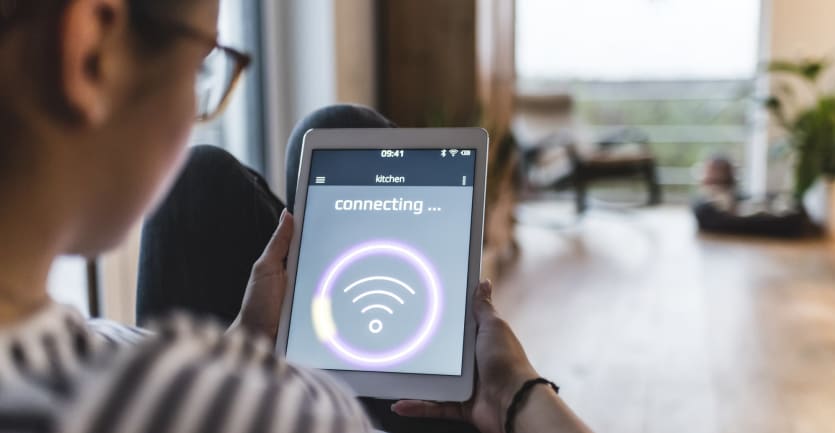Coronavirus Deepens the Digital Divide for College Students
Writer
Writer
www.bestcolleges.com is an advertising-supported site. Featured or trusted partner programs and all school search, finder, or match results are for schools that compensate us. This compensation does not influence our school rankings, resource guides, or other editorially-independent information published on this site.
Turn Your Dreams Into Reality
Take our quiz and we'll do the homework for you! Compare your school matches and apply to your top choice today.
- The national shutdown continues to deepen the digital divide for millions of Americans.
- The lack of internet access is a much larger problem for rural and underserved students.
- There needs to be a national effort to increase access to technology and the internet.
At the end of March, college campuses across the country closed and sent students home to take classes online. However, the assumption that all college students have a permanent home, and that they would have internet access when they got there, is false for many students.
As the crisis continues to unfold, it's becoming clearer every day how educational disruptions caused by the COVID-19 pandemic have deepened the digital divide for millions of American college students — particularly those who belong to underserved populations.
The digital divide refers to unequal access to computers and the internet due to socioeconomic and geographic barriers. Across the world, the digital divide is felt most by minorities, women, and the elderly. Individuals without reliable, high-speed internet at home benefit from fewer educational and economic opportunities.
Many low-income Americans lack access because they cannot afford the monthly bills that come with connecting a computer to high-speed internet.. Source: — Pew Research Center
Public resources usually help bridge the gap — schools, libraries, and workplaces offer computers and internet access — but most gathering places have been shut down in attempts to limit the transmission of the virus. Without a reliable internet connection, individuals may struggle to access schoolwork, job listings, unemployment benefits, or video conferencing.
Paying for devices and broadband internet was already a major hurdle for many students and families. With the economy taking such a big hit, these difficulties are likely exacerbated. The unemployment rate was 3.5% in February. Some economists predict that April's unemployment rates hit 16%, others say 20% or higher. When the Bureau of Labor Statistics releases April figures this Friday, they are expected to show the highest unemployment rate on record.
Students and families are feeling the financial strain of the pandemic. Not being able to afford internet access causes students to suffer academically now, and it could also hurt their job prospects down the road.

The Internet Accessibility Problem in the United States
The digital divide is a global issue. According to United Nations estimates, about half of the world's population (46%) is not connected to the internet. Getting more of the world online is among the U.N. sustainable development goals.
Only 47% of students who live in rural areas have high-speed internet access, compared to 77% of those in suburban areas.. Source: — Quello Center, Broadband And Student Performance Gaps

According to a 2019 report from the Federal Communications Commission (FCC), around 21 million people in America don't have access to broadband at home. However, this might be a conservative count. For example, Microsoft estimated 162.8 million people in the U.S. aren't accessing broadband speeds at home.
In the United States, unequal broadband access has historically affected students' ability to complete homework and find academic success. In an op-ed for The Hill, Jim Steyer, the founder of Common Sense Media, points out that the digital divide not only causes a "homework gap," but it also exacerbates inequality around opportunities and access to services and benefits.
Broadband internet is not available in many rural areas and inner cities. It is also spotty on Native American lands. A survey commissioned by Microsoft and the National 4-H Council found that 20% of rural youth lack access to broadband at home, regardless of whether it's available where they live.
How Schools Are Managing the Digital Divide
The technical logistics of online education have colleges, professors, and students scrambling to adapt. The makeshift approach to online education adopted during the pandemic has caused some educators to speculate that students will be turned off by online education after the crisis resolves. Others think that students will come to appreciate online education's convenience and learning benefits.
Most colleges plan to use hybrid learning, featuring both in-person and online elements, during the coming academic year.

Whether more students ultimately opt for remote experiences, more and more aspects of college will be available online. Most colleges plan to use hybrid learning, featuring both in-person and online elements, during the coming academic year.
Many colleges are loaning out devices and hotspots to students while stay-at-home orders are in place. Still, technology can suffer from reliability issues. Crashing apps, patchy service, and inevitable screen cracks and system malfunctions mean that staying online could be just as much of a problem for low-income students as getting online.
Once campuses reopen, a heavier reliance on technology will mean that schools need to work even harder to ensure students have equal access to devices and broadband.
Providing Connections Amid the Pandemic
Because so many students depend on schools and libraries for internet access, some institutions have left the Wi-Fi on, even after locking their doors. The online education plan for some students involves connecting to the internet from a parking lot.
While students are taking advantage of ad-hoc and existing solutions to overcome the digital divide (e.g., nonprofits like PCs for People are seeing an unprecedented flood of applicants), companies and organizations are taking new measures to provide internet access to more Americans.
The FCC is gathering pledges from broadband and telephone service providers, as well as trade associations, to prevent Americans from losing connectivity due to financial hardship during the COVID-19 pandemic.
According to the FCC, over 700 broadband internet providers, telephone companies, and trade associations have signed the Keep America Connected Pledge. These organizations promise:
-
Not to terminate service to any residential or small business customers because of their inability to pay their bills due to disruptions caused by the coronavirus pandemic; -
To waive any late fees that any residential or small business customers incur because of their economic circumstances related to the coronavirus pandemic; and -
To open their Wi-Fi hotspots to any American who needs them.
In addition, the FCC's Lifeline Program provides a $9.25 monthly subsidy for wireless or landline telephone service for low-income families.
Individual internet service providers have also stepped up. AT&T is providing unlimited cellular data service to school-issued tablets, 4G LTE-enabled laptops, and hotspot devices. Comcast is offering free broadband for low-income households for 60 days, and Charter is offering free internet access for students for 60 days.
Federal student loan relief and stimulus checks are helping some students, but student advocates want to see a targeted approach to tackling the digital divide in the age of the coronavirus. The National Digital Inclusion Alliance is working with Senator Patty Murray from Washington state on a "connectivity stimulus." This stimulus plan would put $500 million toward devices, internet service, and tech support.

Overcoming the Digital Divide to Achieve Digital Literacy
Accessing the internet is only part of the battle. Students also require devices to go online, run educational programs, conduct research, and write essays. Although many Americans own a smartphone, these devices can't stand in for a desktop, laptop, or tablet for serious homework assignments.
Students who depend on a cell phone alone for internet access from home and for access to learning materials do as poorly or worse than students with no internet. A study by Michigan State University surveyed over 3,000 students in grades 8-11. Findings showed that the average GPA of students who use a cell phone for internet access at home was actually lower than the average GPA of students who have no internet access at home at all.
Howard Pinder, a workforce development and adult education specialist, argues that the digital divide goes beyond internet and devices. Computer skills are also needed to make use of the internet's opportunities.
Without the practical knowledge required to put the internet to use, connectivity does little good. And it takes time to learn digital skills, Pinder says. The more complex or intricate the digital task, the more skills you need, and the longer acquiring those skills takes. Students need to have access to working devices to develop their abilities over time.
The three basic things you need for digital access are internet connectivity, a workable device, and then the actual functional skills themselves. All three of those are important pieces in digital connection.. Source: — Howard Pinder, Assistant Director of Workforce and Economic Inclusion, Drexel University
The digital divide and the digital literacy divide go hand in hand. According to Michigan State University research, "The gap in digital skills between students" without and with home internet access "is equivalent to the gap in digital skills between 8th and 11th grade students."
Digital literacy is vital for academic and career success. Students on the wrong side of the digital divide often lack computer skills, but the students who most need technical assistance often don't ask for it. In a study from Indiana University, affluent students experiencing computer problems were more likely to ask instructors for help or extended deadlines than low-income students.
Students who fail to acquire digital literacy in school will also be at a disadvantage on the job market. Jobs that require digital skills pay more than jobs that do not, according to research from Burning Glass Technologies. Digital skills open the door to better paying jobs, and more jobs in general; digital middle-skill jobs represent roughly 38% of all job postings.
Even after the pandemic ends, schools and organizations should prioritize providing students with access to devices and internet services and teaching learners the digital skills needed to use these powerful tools.





